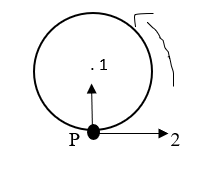
Give some examples of circular motion.
Answer
592.2k+ views
Hint: Circular motion is a motion of a body in a circular path.
Complete step by step answer:
If the particle has to follow a circular path, two forces must act on the particle, they are-
1. Tangential force
2. Centripetal force
Then only particles exhibit circular motion.
Consider a circular motion of an object ‘P’ as shown below:

We can find examples for the circular motion in our daily life, let us look at some among them-
1. Consider motion of a satellite around the earth it moves in a circular path making it circular motion.
2. Hands of the clock move in a circular path.
3. If you tie a stone to a rope and swing it, you can see that the stone follows the circular path which is a circular motion.
4. The electron motion in a perpendicular magnetic field is an example of circular motion.
5. In your house if you switch on the fan the blades of a fan move in circular motion.
6. An ant sitting on the circumference of the spinning top traces a circular path.
Additional information:
There are two types of circular motions, they are-
Uniform circular motion
Non uniform circular motion
In case of uniform circular motion, it is a rotation of an object in a fixed axis where the radius is fixed and has constant angular speed and angular acceleration but angular velocity changes but in case of non-uniform motion there is change in angular speed with respect to time.
Note: Students may get confused between rotational motion and circular motion and will write the examples of rotational motion such as:
Earth rotating about its axis, a top spinning about its axis, which is incorrect.
The main difference is that rotational motion is a motion of a body about its Centre of Mass and circular motion is the motion of a body around a fixed centre maintaining a constant distance from it.
Thus, if the centre of mass of an object is not moving then it is rotational motion and if centre of mass of an object moving in a circle then its circular motion.
To make it clearer, consider the above mentioned example of a fan - The entire fan is making rotation by spinning about its own axis but the points on blades of a fan are making circular motion around the fixed axis.
Complete step by step answer:
If the particle has to follow a circular path, two forces must act on the particle, they are-
1. Tangential force
2. Centripetal force
Then only particles exhibit circular motion.
Consider a circular motion of an object ‘P’ as shown below:

We can find examples for the circular motion in our daily life, let us look at some among them-
1. Consider motion of a satellite around the earth it moves in a circular path making it circular motion.
2. Hands of the clock move in a circular path.
3. If you tie a stone to a rope and swing it, you can see that the stone follows the circular path which is a circular motion.
4. The electron motion in a perpendicular magnetic field is an example of circular motion.
5. In your house if you switch on the fan the blades of a fan move in circular motion.
6. An ant sitting on the circumference of the spinning top traces a circular path.
Additional information:
There are two types of circular motions, they are-
Uniform circular motion
Non uniform circular motion
In case of uniform circular motion, it is a rotation of an object in a fixed axis where the radius is fixed and has constant angular speed and angular acceleration but angular velocity changes but in case of non-uniform motion there is change in angular speed with respect to time.
Note: Students may get confused between rotational motion and circular motion and will write the examples of rotational motion such as:
Earth rotating about its axis, a top spinning about its axis, which is incorrect.
The main difference is that rotational motion is a motion of a body about its Centre of Mass and circular motion is the motion of a body around a fixed centre maintaining a constant distance from it.
Thus, if the centre of mass of an object is not moving then it is rotational motion and if centre of mass of an object moving in a circle then its circular motion.
To make it clearer, consider the above mentioned example of a fan - The entire fan is making rotation by spinning about its own axis but the points on blades of a fan are making circular motion around the fixed axis.
Recently Updated Pages
Why are manures considered better than fertilizers class 11 biology CBSE

Find the coordinates of the midpoint of the line segment class 11 maths CBSE

Distinguish between static friction limiting friction class 11 physics CBSE

The Chairman of the constituent Assembly was A Jawaharlal class 11 social science CBSE

The first National Commission on Labour NCL submitted class 11 social science CBSE

Number of all subshell of n + l 7 is A 4 B 5 C 6 D class 11 chemistry CBSE

Trending doubts
What is meant by exothermic and endothermic reactions class 11 chemistry CBSE

10 examples of friction in our daily life

One Metric ton is equal to kg A 10000 B 1000 C 100 class 11 physics CBSE

1 Quintal is equal to a 110 kg b 10 kg c 100kg d 1000 class 11 physics CBSE

Difference Between Prokaryotic Cells and Eukaryotic Cells

What are Quantum numbers Explain the quantum number class 11 chemistry CBSE




